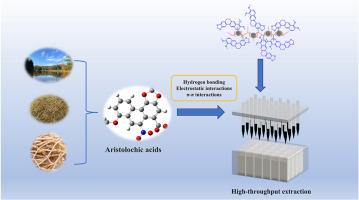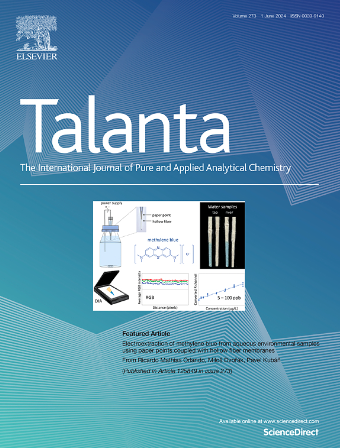基于小檗碱的超交联聚合物:用于高通量分析环境水和草本植物中马兜铃酸的先进固相微萃取技术。
IF 6.1
1区 化学
Q1 CHEMISTRY, ANALYTICAL
引用次数: 0
摘要
本研究以二甲氧基甲烷为交联剂,通过Friedel-Crafts烷基化反应合成了一种新型的小檗碱阴离子交换型高交联聚合物(BBR-HCPs)。该聚合物对马兜铃酸(AAs)具有良好的吸附能力。此外,BBR-HCPs与AAs之间存在疏水、π-π堆叠、氢键和静电相互作用等多种相互作用。采用24孔板,采用高效液相色谱二极管阵列检测器(HPLC-DAD)进行仪器分析,制备了以BBR-HCPs为吸附剂,聚丙烯腈(PAN)为粘合剂的固相微萃取(SPME)涂层,用于草药植物中原子吸收剂的高通量测定。优化和验证的BBR-HCPs-SPME/HPLC-DAD方法在5-400 ng mL-1范围内具有良好的线性关系,R2为0.9974。检测限(S/N = 3)为0.03 ~ 0.150 ng mL-1,加样回收率为82.6 ~ 117.8%,相对标准偏差(rsd)小于10.49%。该研究强调了BBR-HCPs作为一种有前途的吸附剂选择性提取和富集原子吸收剂的潜力,同时引入了一种可靠的新策略来监测水和草药植物样品中的痕量原子吸收剂。本文章由计算机程序翻译,如有差异,请以英文原文为准。

Berberine-based hypercrosslinked polymer: Advanced solid-phase microextraction for high-throughput analysis of aristolochic acids in environmental water and herbal plants
In this study, a novel berberine based anion-exchanged hypercrosslinked polymer (BBR-HCPs) was synthesized via Friedel-Crafts alkylation using dimethoxymethane as a cross-linking agent. The proposed BBR-HCPs polymer exhibited excellent adsorption capacities for aristolochic acids (AAs). Moreover, there are various interactions such as hydrophobic, π-π stacking, hydrogen bonding, and electrostatic interactions between BBR-HCPs and AAs. A solid phase microextraction (SPME) coating, prepared with BBR-HCPs as the sorbent and polyacrylonitrile (PAN) as the binder, was applied for the determination of AAs in herbal plants using a 24-well plate for high-throughput, with instrumental analysis carried out via high performance liquid chromatography with diode array detector (HPLC-DAD). The optimized and validated BBR-HCPs-SPME/HPLC-DAD method exhibited excellent linearity over range of 5–400 ng mL−1 with R2 > 0.9974. Detection limits (S/N = 3) for AAs were found to be 0.03–0.150 ng mL−1, with recoveries ranging from 82.6 to 117.8 % and relative standard deviations (RSDs) less than 10.49 %. This study underscores the potential of BBR-HCPs as a promising adsorbent for selective extraction and enrichment of AAs while introducing a reliable novel strategy for monitoring trace amounts of AAs in water and herbal plant samples.
求助全文
通过发布文献求助,成功后即可免费获取论文全文。
去求助
来源期刊

Talanta
化学-分析化学
CiteScore
12.30
自引率
4.90%
发文量
861
审稿时长
29 days
期刊介绍:
Talanta provides a forum for the publication of original research papers, short communications, and critical reviews in all branches of pure and applied analytical chemistry. Papers are evaluated based on established guidelines, including the fundamental nature of the study, scientific novelty, substantial improvement or advantage over existing technology or methods, and demonstrated analytical applicability. Original research papers on fundamental studies, and on novel sensor and instrumentation developments, are encouraged. Novel or improved applications in areas such as clinical and biological chemistry, environmental analysis, geochemistry, materials science and engineering, and analytical platforms for omics development are welcome.
Analytical performance of methods should be determined, including interference and matrix effects, and methods should be validated by comparison with a standard method, or analysis of a certified reference material. Simple spiking recoveries may not be sufficient. The developed method should especially comprise information on selectivity, sensitivity, detection limits, accuracy, and reliability. However, applying official validation or robustness studies to a routine method or technique does not necessarily constitute novelty. Proper statistical treatment of the data should be provided. Relevant literature should be cited, including related publications by the authors, and authors should discuss how their proposed methodology compares with previously reported methods.
 求助内容:
求助内容: 应助结果提醒方式:
应助结果提醒方式:


